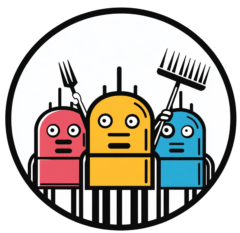The world is abuzz with the promise of domestic robots – devices designed to transform our homes and lives. Yet, as I watch the glossy promotional videos and lofty claims, I can’t help but wonder if the focus is all wrong. Many companies are so busy trying to make their robots look and act like humans that they’re overlooking the more practical needs of their future users. Let’s face it: most of us don’t want a humanoid butler pouring our tea. We need a robust, functional workhorse for the gritty, unpleasant tasks we’d rather avoid.
Here’s my vision for the ideal domestic robot: a stable, four-legged base reminiscent of Boston Dynamics’ Spot, combined with three highly dexterous human-like arms. Why three arms? Because two arms can barely keep up with us! Imagine one arm chopping onions, another scrubbing the sink, and the third holding your phone so you can issue the next set of commands. This hybrid design would prioritise function over form, doing what needs to be done efficiently without worrying about whether it looks like Jeeves from Downton Abbey.
The obsession with humanoid designs feels like a distraction. While it’s true that a human shape can navigate environments designed for humans, the same can be said of a design tailored for stability and precision. A Spot-like robot would excel on uneven surfaces, tackle cluttered rooms, and never wobble when navigating a staircase. Add to that three human-like arms with opposable thumbs, and you’ve got a machine that can handle everything from folding laundry to assembling flat-pack furniture.
Many promotional videos show robots serving tea or fetching drinks, but is that really what we want? For most of us, these small rituals – like making a cuppa or walking to the kitchen – are enjoyable. What we need help with are the truly unpleasant chores: cleaning the cat’s litter box, killing flies, or deep-cleaning the bathroom. A practical domestic robot should focus on the drudgery of housework, not the activities we find relaxing or rewarding.
Additionally, there’s potential for a robot to encourage healthier lifestyles. Imagine it acting as a personal trainer, setting up circuits for home workouts, or nudging you to get off the couch and move. A robot that supports your well-being could be far more valuable than one enabling laziness.
One challenge is ensuring the robot communicates its status effectively. It doesn’t need to talk like a human, but it does need to let you know if it’s overworked, running low on battery, or stuck on a task. This could be as simple as lights and sounds: green for fully charged, yellow for needing a break, and red for imminent shutdown.
If we want a touch of personality, perhaps it could mimic something like R2-D2’s expressive chirps or have a mechanical “face” with simple eyes and mouth shapes. A furrowed “brow” for frustration or a cheeky wink when it’s finished cleaning might make interactions more engaging without veering into uncanny valley territory.
Finally, not all robots need to be all things. There’s a place for an electronic companion – a ChatGPT in a body – that provides emotional support and conversation. But that doesn’t need to be the same device as the one scrubbing your floors. Splitting these roles allows each machine to specialise, rather than trying to build a jack-of-all-trades.
The domestic robots currently in development are exciting, but their designers might need to step back and ask a simple question: what do people actually want from a robot? A humanoid appearance might grab headlines, but it’s the practical, efficient, and steady designs that will win over homes. A three-armed, four-legged workhorse that handles unpleasant tasks, encourages healthier habits, and communicates clearly would be transformative – and it doesn’t need to look like Jeeves to do it.

One thought on “Three-Armed Spot: The Domestic Robot We Really Need”